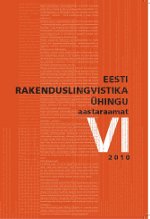Vähemuskeelte elujõulisus ja arengusuundumused Eesti venekeelsetes keelekeskkondades
The viability and development trends of Estonian minority languages in segregative language environments
Author(s): Elvira KüünSubject(s): Language and Literature Studies
Published by: Eesti Rakenduslingvistika Ühing (ERÜ)
Keywords: education policy; language policy; language choice; language competence; home language; Estonian; Russian; other languages
Summary/Abstract: The language policy of the European Union promotes diversity. Consequently, it is an important matter for Estonia as one of its member states to find out what the current language situation in Estonia is. It is necessary to get an overview of what languages the language minority groups in Estonia use in the public sphere and in informal communication, and whether there is a need to teach minority languages more extensively at Estonian schools. The government’s education policy should take this information into account. According to the Estonian population registry—the official source of information on what the people in Estonia claim to be their mother tongues—the 142 ethnic groups living in Estonia speak 109 different mother tongues (the biggest minority group is Russian). Unfortunately, the register does not contain more specific data: for instance on what languages are used at home, i.e. in the informal environment. The speakers of minority languages in Estonia are immigrants who have mainly come to live and work here in the industrial areas and are currently forming segregated groups. Although at present there are quite many Sunday schools operating in Estonia where the children of minority language group representatives are taught their mother tongue and their culture of origin, there still remains a threat to their languages’ existence in Estonia. Common reasons for this are cultural pressure and the lower prestige the minority language has in the eyes of the speakers themselves. The speakers’ number is not always decisive here—their attitude towards their mother tongue plays the main role in this case.
Journal: Eesti Rakenduslingvistika Ühingu aastaraamat
- Issue Year: 2010
- Issue No: 6
- Page Range: 135-155
- Page Count: 20
- Language: Estonian

